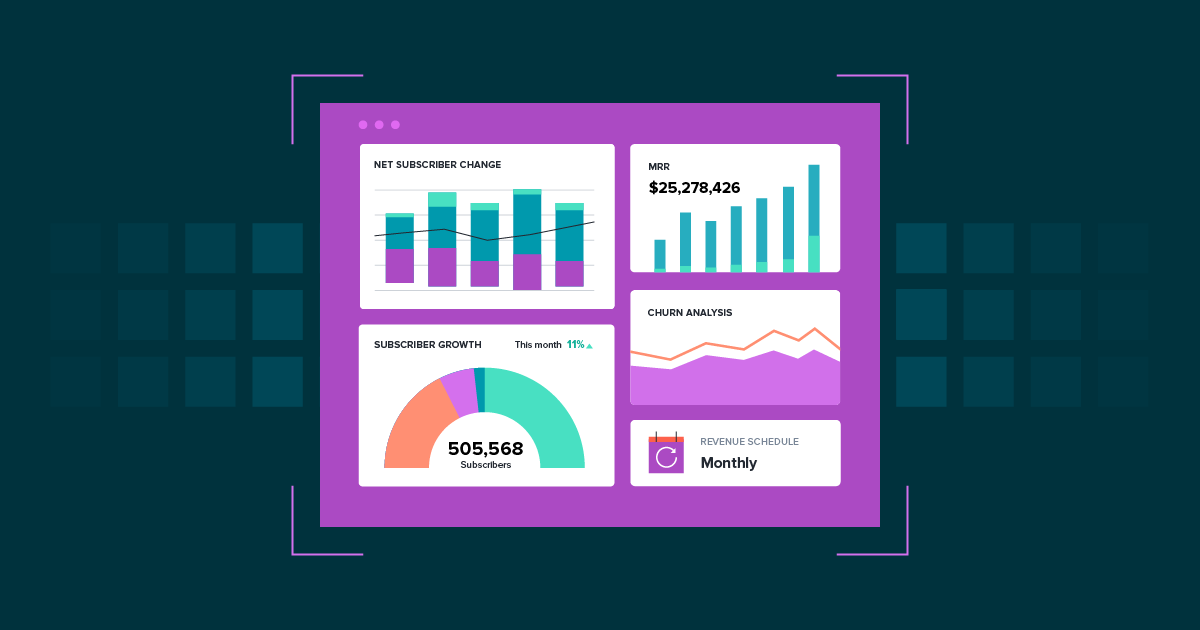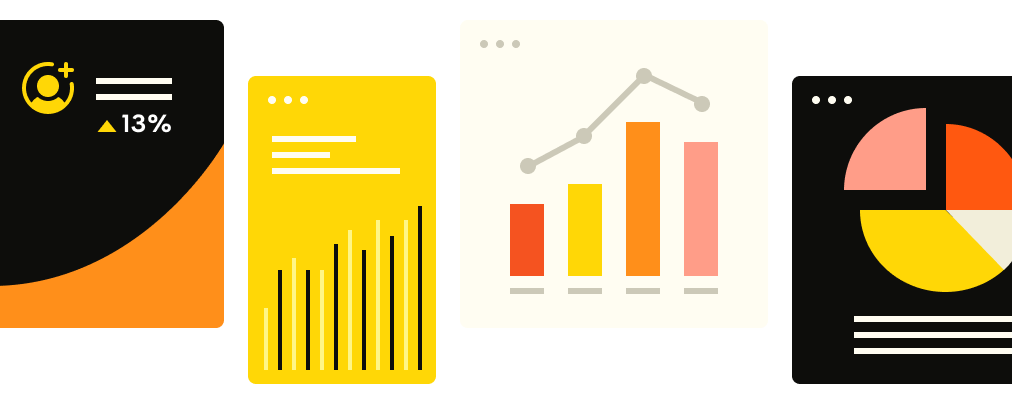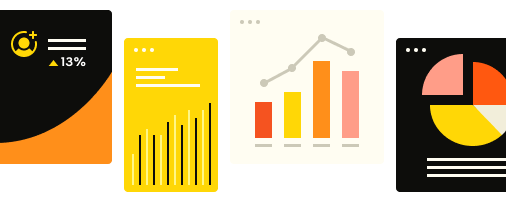Recurring revenue management software

The recurring revenue model has taken the business world by storm. According to Forbes, more than 90% of technology organizations are in the process of moving to this business model—or have plans to do so. However, only 55% consider themselves ready for the shift, which is likely far lower for non-technology companies.
So, why don’t they feel ready?
In order to support a subscription-based model, organizations need the processes behind their marketing, sales, and services to be on point. However, 44% of technology organizations are still determining whether their established processes give their customers a smooth experience and are considered reliable.
Recurring revenue management software can help address many of these needs by automating the mundane tasks that power your day-to-day operations to give you high-level strategic insights to guide your company down the right path. With the best subscription software, you can provide your customers with plan options, slash involuntary client churn, ease the burden on your financing and accounting teams, generate subscription-based business model metrics, and much more.
But before we get into the kinds of software, you’ll need to understand the underlying revenue model and why it is a viable choice for any business, today and in the future.
What is a recurring revenue model?
A recurring revenue model is a business model where companies charge not just on a one-time basis but consistently at regular intervals: weekly, monthly, annually, or somewhere in between. These regularly scheduled payments keep consistent revenue streams incoming, easing the company's risk with a steady cash flow.
Examples of this model include automatically renewing subscriptions like Paramount+ and Twitch and long-term contracts like Sprout Social and LiveChat.
The revenue model has increased in recent years as companies have fallen in love with the steady stream of subscription payments. While consumers appreciate the convenience, simplicity, and spread-out costs that come with subscriptions. The bottom line is recurring subscription services mean more affordability for consumers and more stability for business owners.
Many companies hesitated to implement a recurring revenue model, thinking, “it won’t work in our industry.” But, in recent years, it’s become clear that subscriptions can work in any industry, with recurring revenue model examples popping up in unexpected places. There’s even a dive bar shirt subscription service showing that starting a subscription business is within reach for most companies.
What are the benefits of a recurring revenue model?
For companies, a recurring revenue model provides stable and predictable cash flow, making it easier to budget for expenses. This model can also showcase more precise analytics metrics.
For consumers, recurring revenue models provide convenience when setting and forgetting their subscriptions and various plan and personalization options that can also lead to customer retention.
What kinds of companies use a recurring revenue model?
All kinds of companies can use a subscription business model. Industries where subscriptions are most commonly offered are SaaS, media, consumer goods, healthcare, and education. In this article, we talked about the dive bar shirt subscription service and a monthly bone box, which shows that a company’s ability to implement a recurring revenue model is only limited by its imagination.
How do I switch to a recurring revenue model?
You need to create a clear value proposition for customers. If your new subscription offering looks like a cash grab, your company will repel potential customers. You need a recurring revenue tech stack to support the switch. Learn more about starting a subscription business.
What key features or software do I need for my revenue management solution?
The subscription business model has many moving parts, and if you don’t have the right software to power it all, you may not be able to fully benefit from this business model. You will need configurable contracts and ease of modifying and tracking billing to manage your recurring and future revenue. Here are the more extensive pieces of the puzzle you will need:
Flexible subscription plan management
When implementing a revenue business model, you must experiment with different plan options and pricing tiers to determine which is best for your customers. In addition, you can offer free trials, promotions, and one-time purchase add-ons to help win the battle for new business.
With flexible subscription management software, you can effortlessly shift between various plan options, finding the best way to bring new customers on board—and keep them around. You can create customizable subscription options that are as unique as your customers.
Effective recurring billing capabilities
Have you ever dealt with a company that hasn’t updated its invoicing processes since the 20th century?
You may get away with billing customers only once in a blue moon without too much damage, but with a subscription-based model, you need your recurring billing to take advantage of as much automation as possible.
You also need recurring billing software to integrate with your accounting and tax solutions. The integrations make it easier for your organization to handle the month-end closing process and track the revenue lifecycle.
Streamlined recurring payment processing
As a subscriber, it may seem like recurring payments are incredibly simple—your payment is usually completed in a few seconds, after all—but there are eight steps involved in recurring payment processing. For every billing cycle, you need these steps to work together without hiccups or slowdowns.
The best software can help you not only improve your payment success rate but also your cost of acceptance. Routing payments through the right gateways can save a lot of monthly revenue—even more so for a company with a product line and geographical diversity.
Intelligent retention and dunning tools
It’s anywhere from five to 25 times more expensive to acquire a new customer than it is to retain an existing one. With that in mind, building customer loyalty should be one of your top priorities.
The bad news is that 13% of all recurring transactions risk failure and lead to involuntary churn, meaning that you risk losing many customers who don’t want to stop using your product.
The good news is that you don’t have to pour many resources into retaining those customers. Automated software like Recurly can reduce involuntary churn by updating bank accounts and payment details, using AI-powered tools to retry payments successfully, and sending automated dunning emails.
Comprehensive view of subscriber data
To optimize your company for growth, you need to measure key subscription model metrics. You could do it yourself, but that will be time-consuming. Better to find software that can do it for you.
With software for the subscription revenue model, you can easily generate valuable data, including subscriber retention trends, promotional campaign performance, revenue reports, key financial metrics, and much more—all from one central location.
Look for subscription management software that integrates with revenue analytics tools for even deeper insights. Recurly, for example, integrates with ChartMogul.
Effective fraud management solutions
Unfortunately, fraud is an ever-present risk for companies—particularly when processing so many payments month after month. Since combing through every transaction to identify suspicious activity is not feasible, you need a solution that prevents fraud.
The thing is, different companies face different sources of fraud. So, you’ll need a fraud management solution that lets you set up customized rules. For example, you may want to decline transactions from high-risk countries. But a high-risk country for another company might be where a high percentage of your customers live.
Recurly integrates with Kount, which does an excellent job of sniffing out fraudsters' evolving trends and tactics.
Revenue recognition automation
With a recurring revenue model, you will record a lot of unearned revenue. To ease the burden on your staff, look for revenue recognition software.
You will want your recurring billing software to integrate with your revenue recognition solution, so you don’t have to manually migrate data. Luckily, Recurly has state-of-the-art compliant revenue recognition software to help you abide by subscription revenue recognition rules.
Integrations for CRM and Data Systems
Your organization has several departments, so your subscription management software must also integrate with systems that aren’t directly related to billing. You should look for pre-built integrations for CRM and data systems in particular.
Using the right CRM can be a make-or-break factor. With a unified, easily accessible view of your customer base, you can provide them with a smooth experience—increasing the chances that your subscription business model venture will be successful.
Connecting your subscription management platform with your CRM can help you automate the quote-to-cash process, saving your financial reporting and sales teams time while reducing the risk of underbilling. At Recurly, we have built an integration with Salesforce.
Data gives your company the potential to make better decisions, but only if you can sort through and act on it. That’s why you need a data system and subscription management software to integrate with it. Recurly integrates with Snowflake, which allows our merchants to automatically export their data directly to the data warehouse.
How Recurly's recurring revenue management can work for you
While subscription management software may be the most important part of your recurring revenue tech stack, it’s not the only part. Recurly, as you may have noticed, seamlessly integrates with the rest of your tech stack.
In addition, our subscription management software has all the necessary features to manage the recurring revenue model. With Recurly, you can:
Choose from a multitude of subscription plan options.
Streamline the recurring billing process.
Optimize the acceptance rate and cost of your recurring payments.
Reduce loss of revenue and potentially reduce your involuntary churn to one-sixth of current levels.
And you don’t have to wait long to get started. Recurly automates current processes to streamline go-to-market speed to help your staff get up to speed in no time.
See it for yourself! Estimate your potential ROI, ARR increase, and subscriber growth with Recurly.


